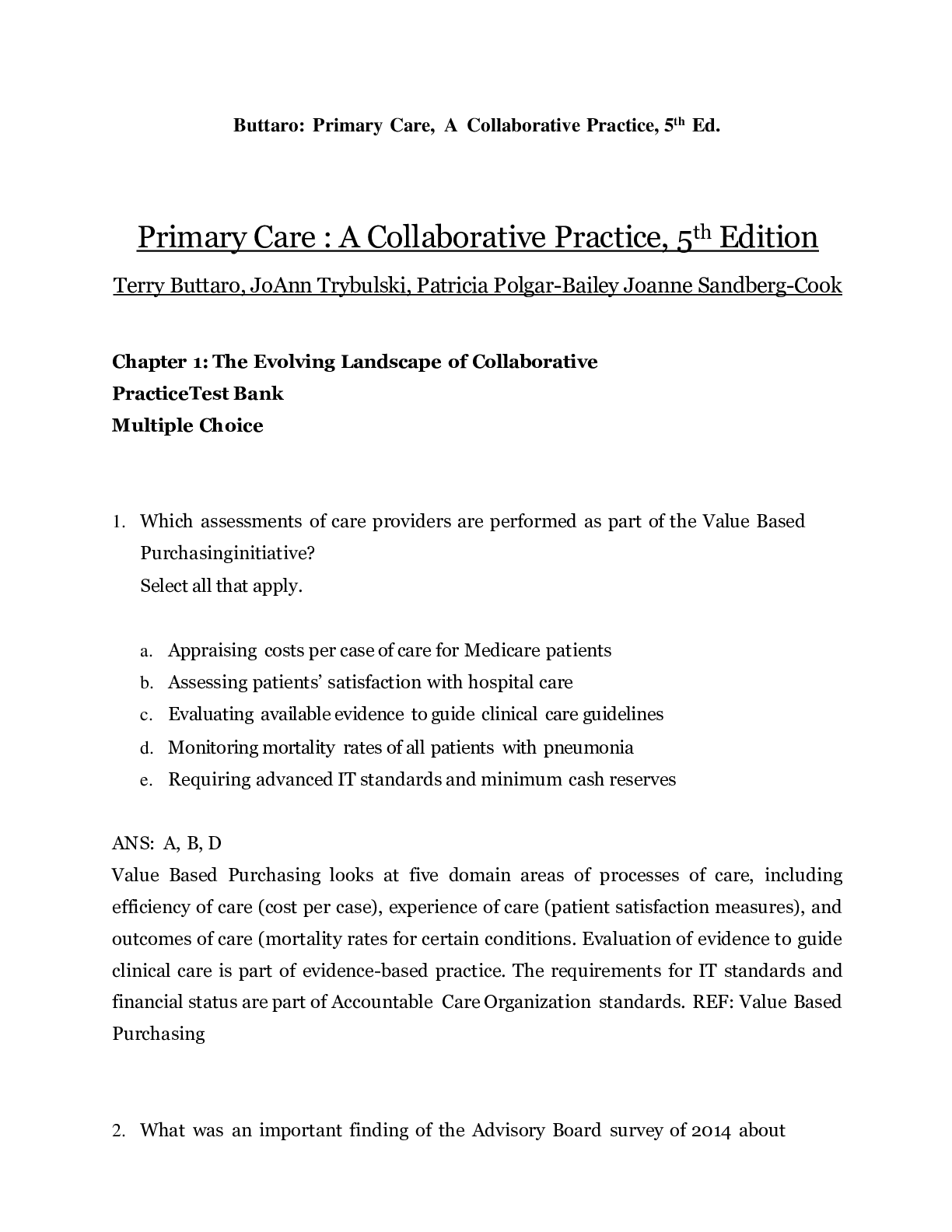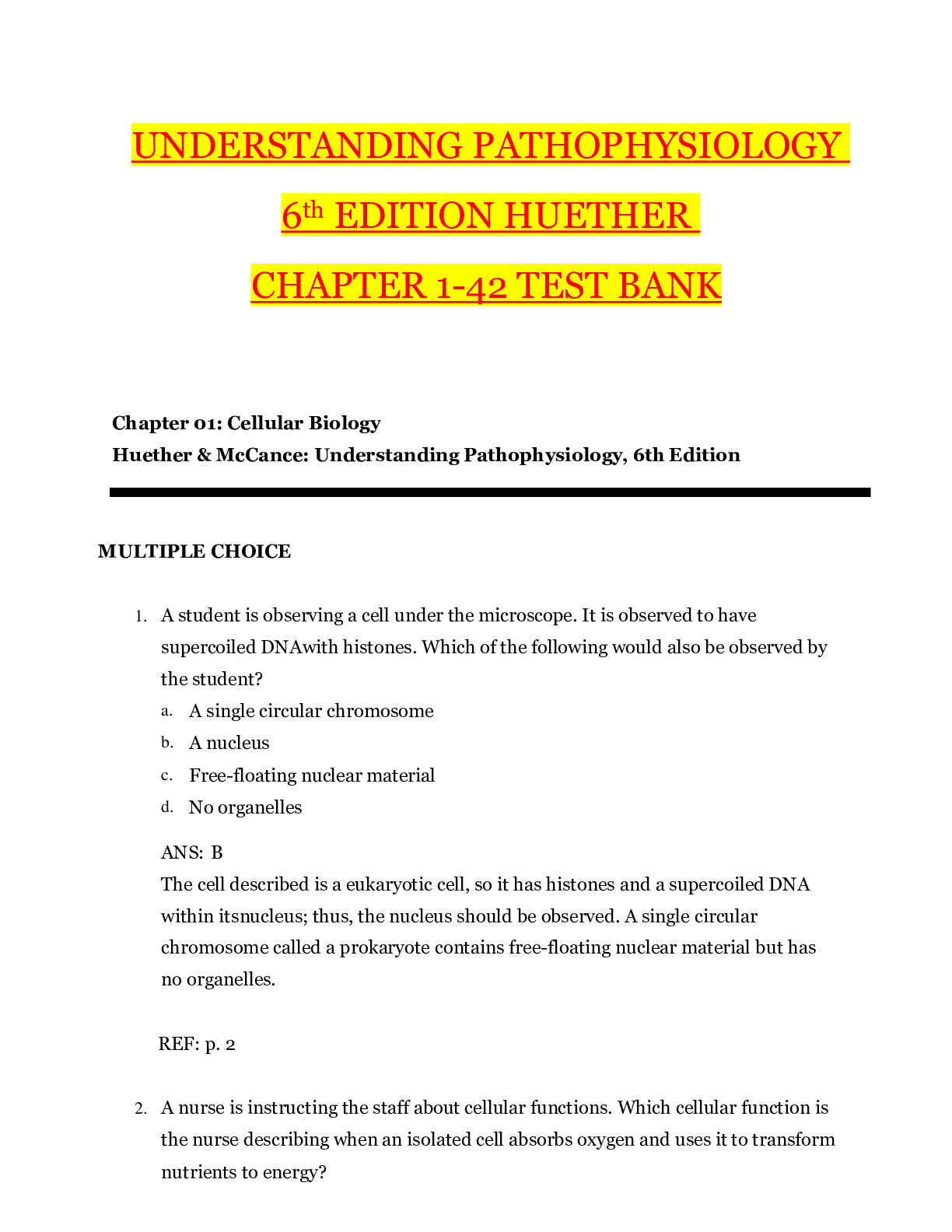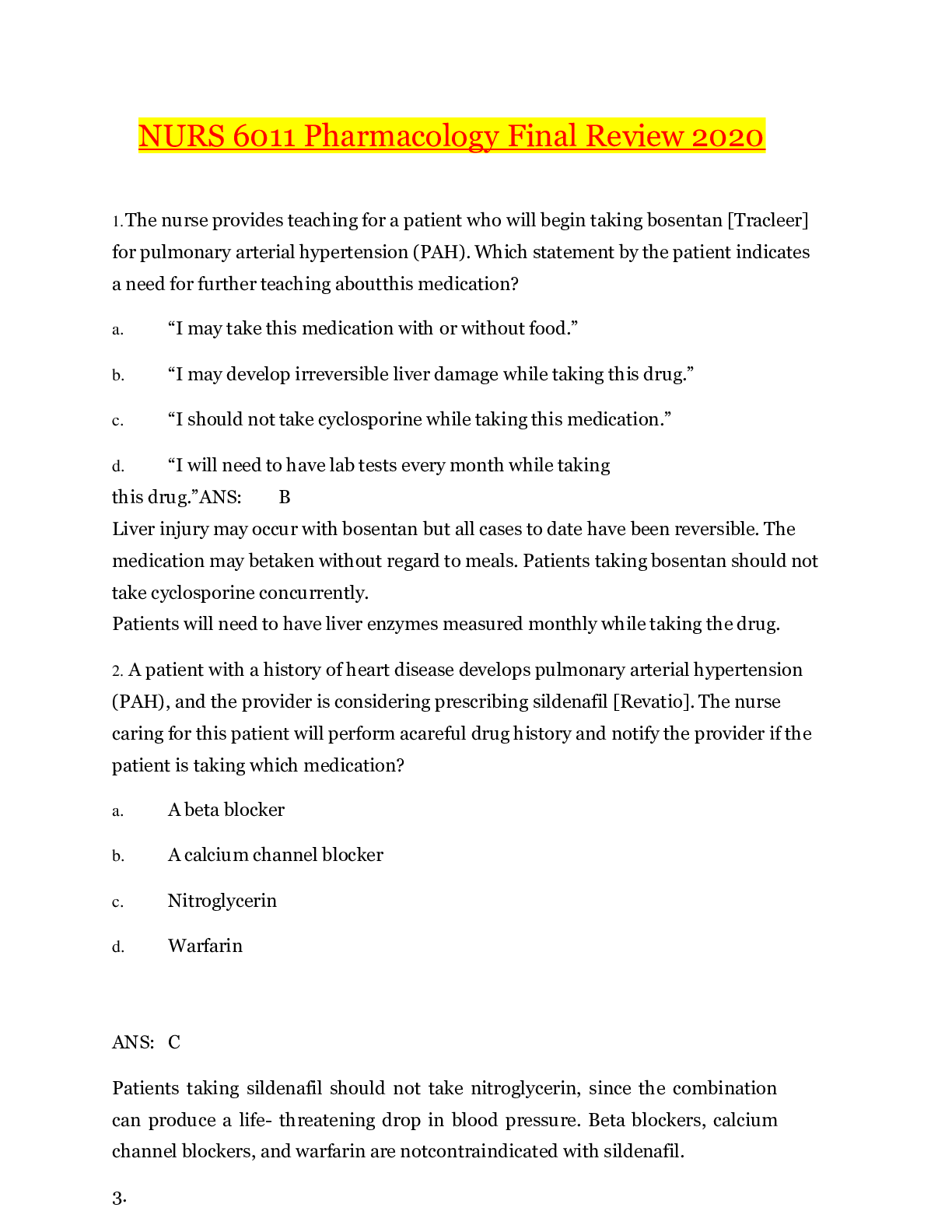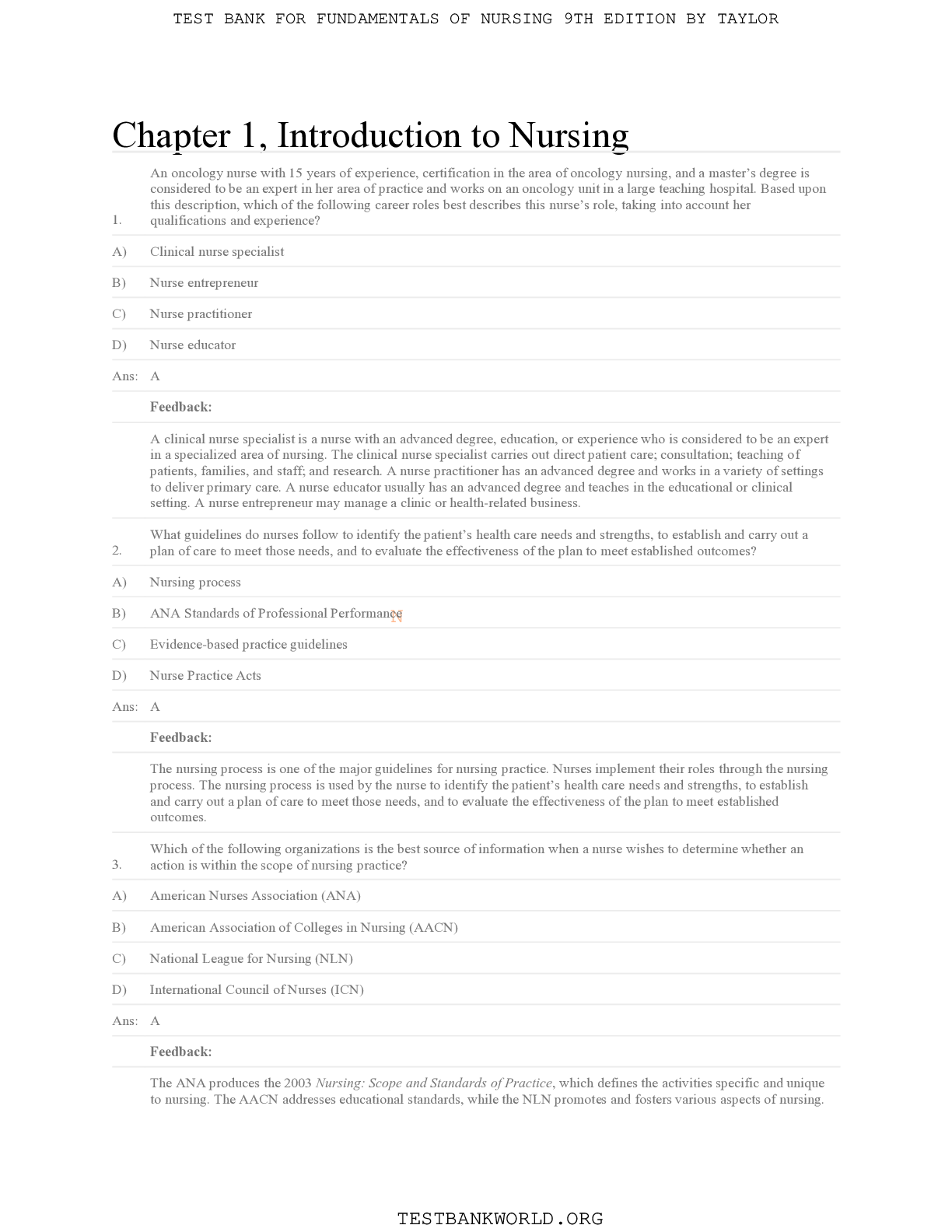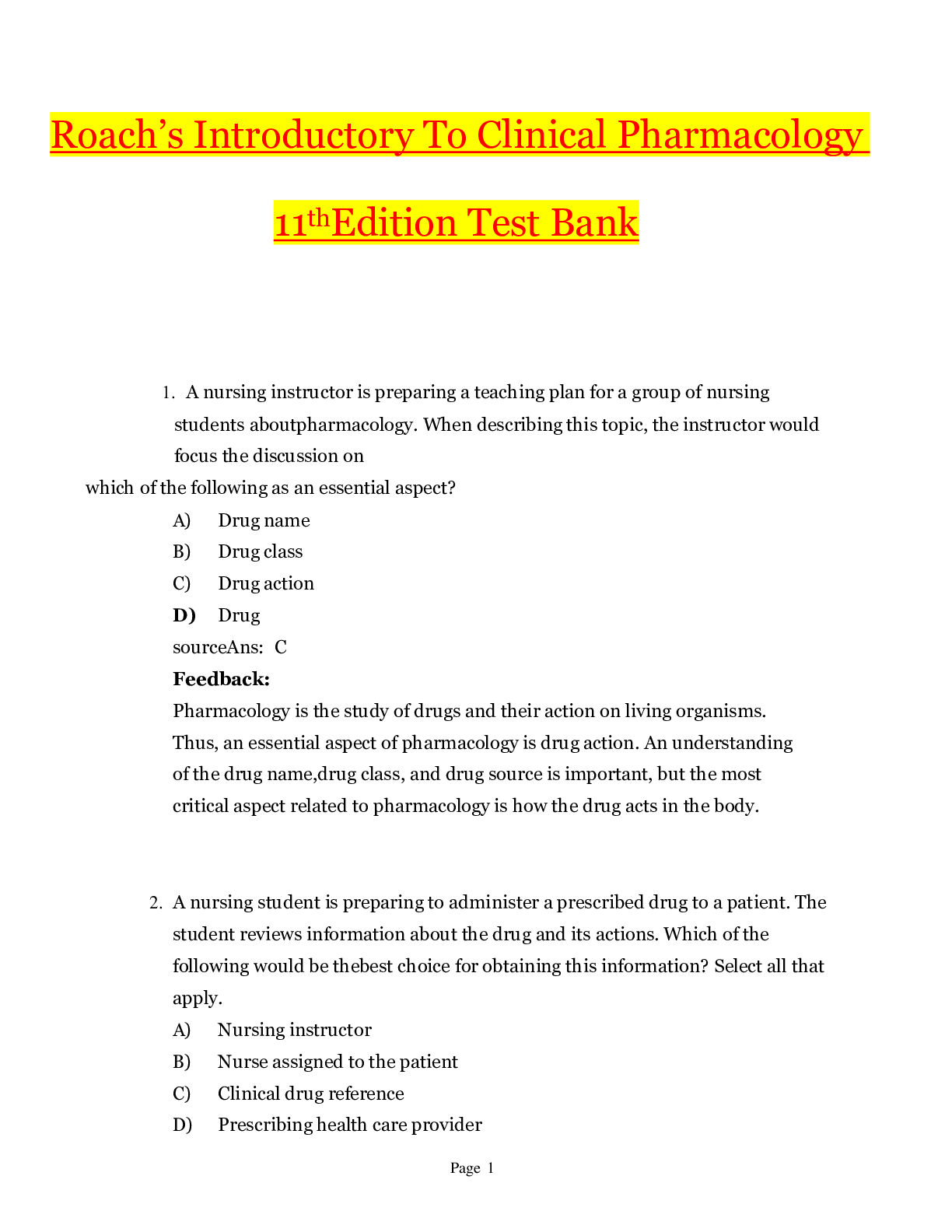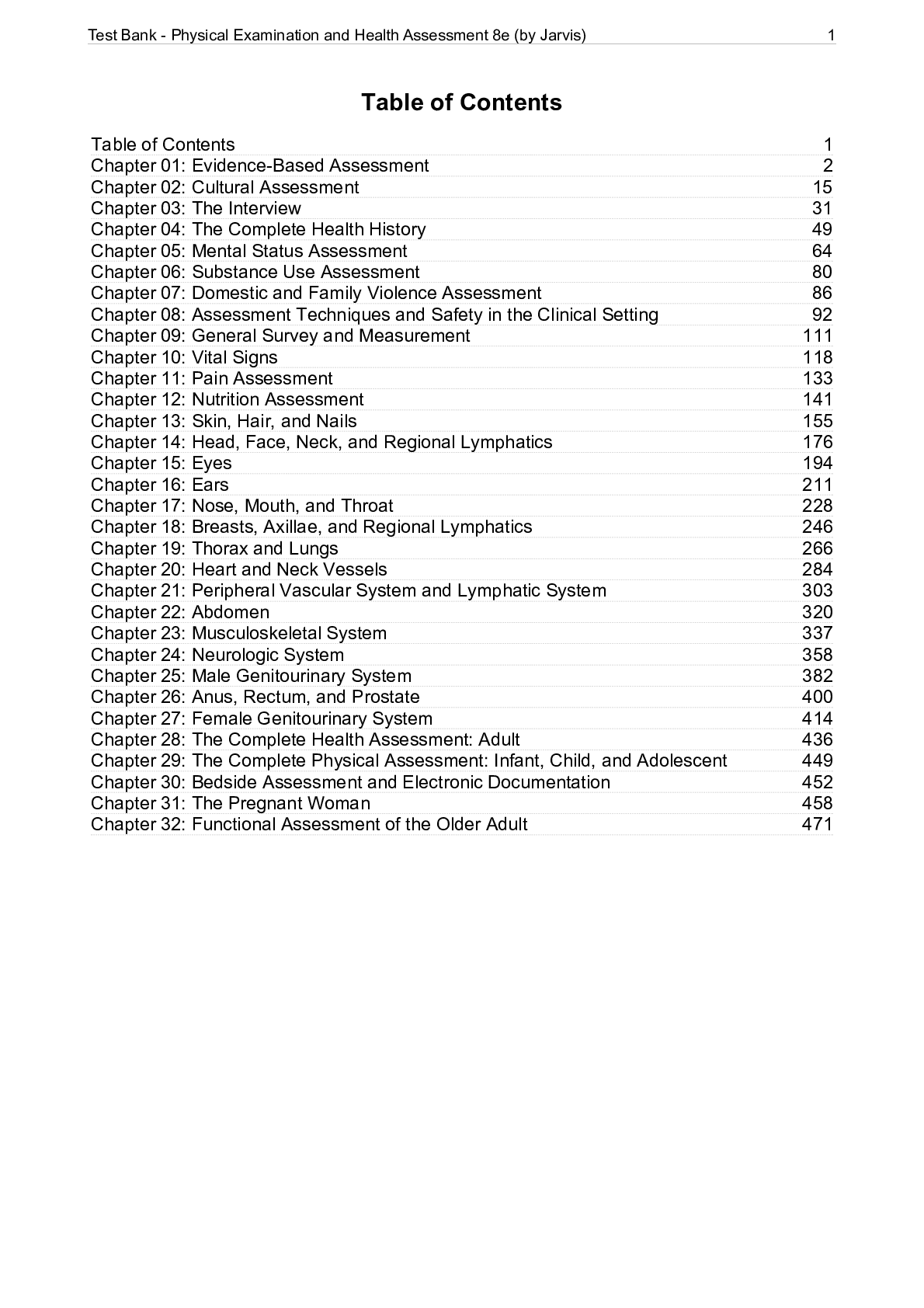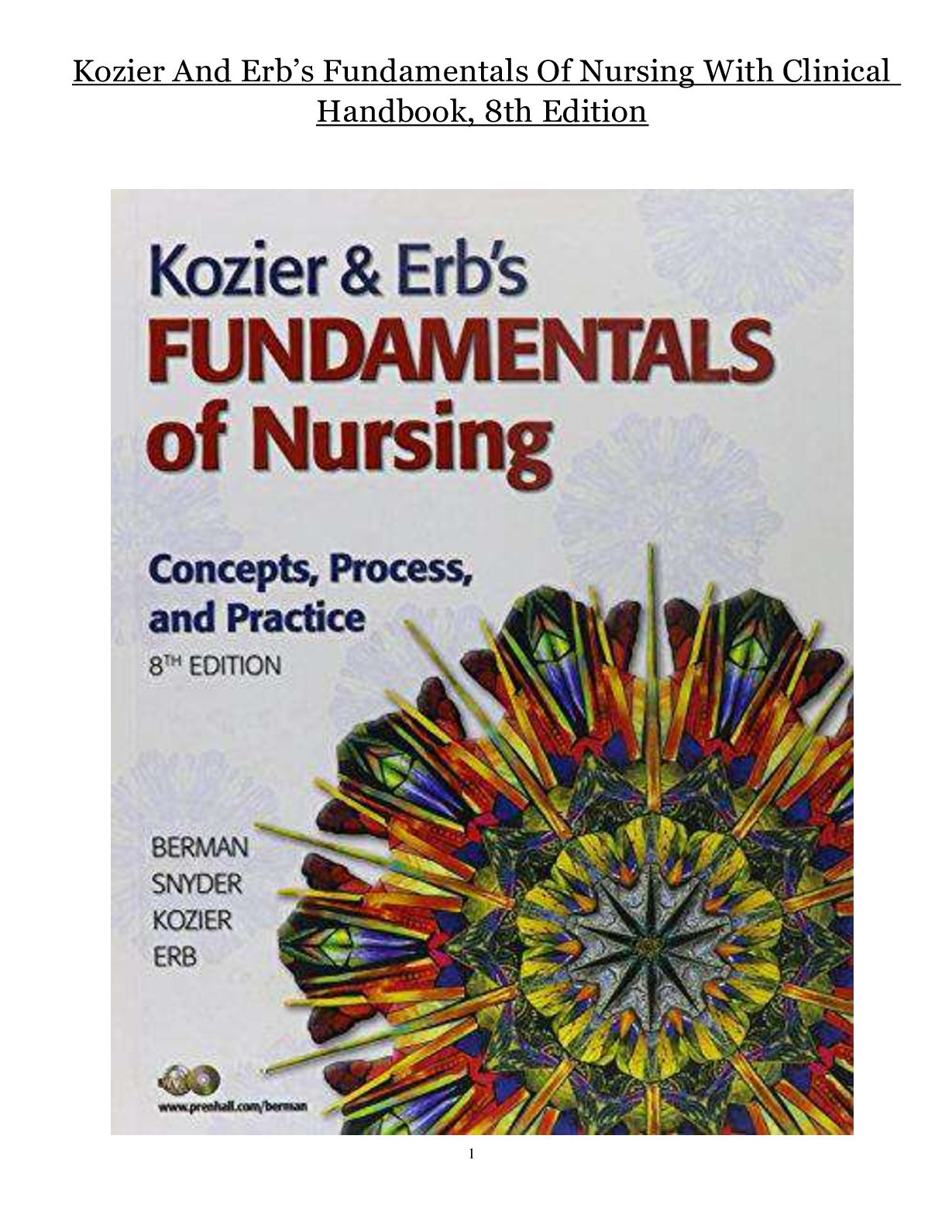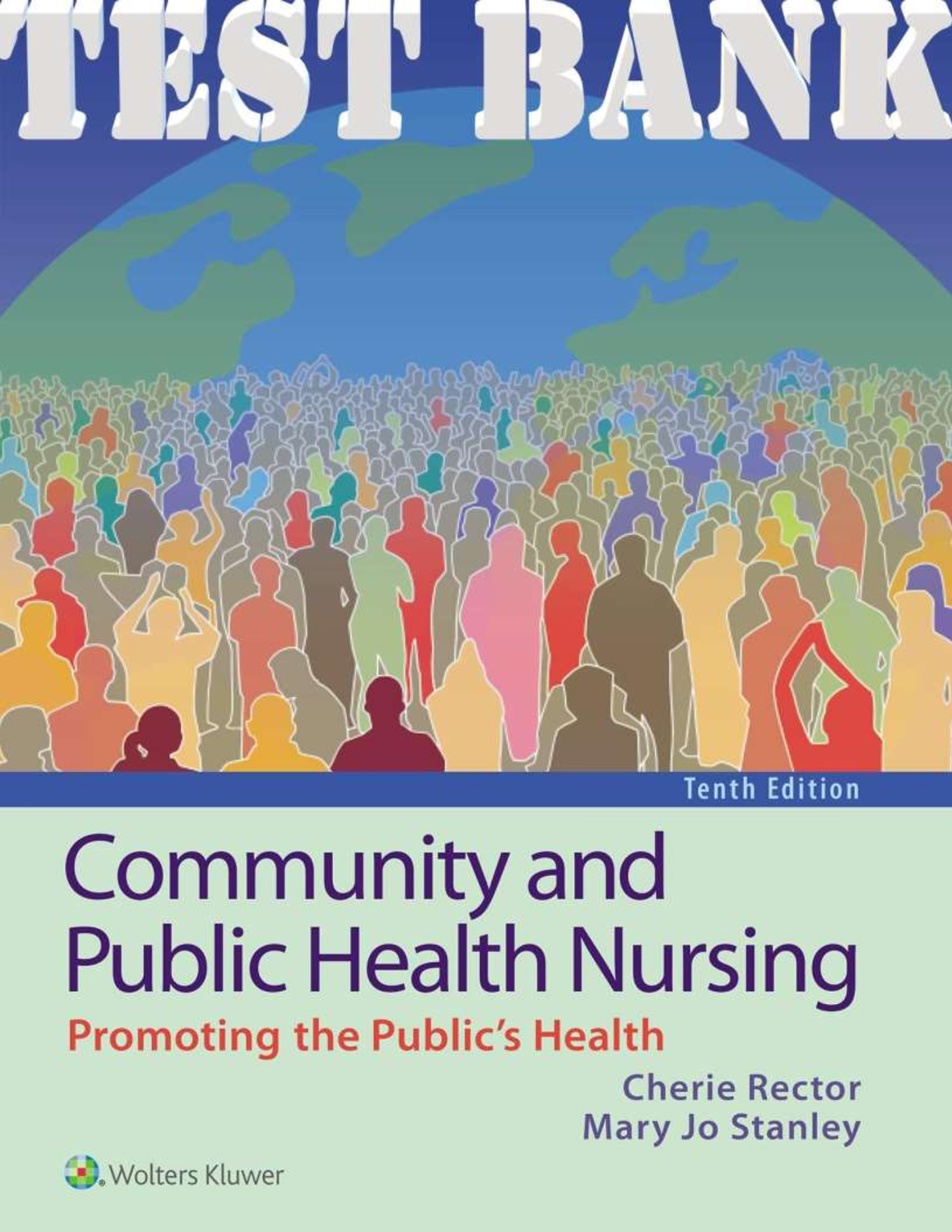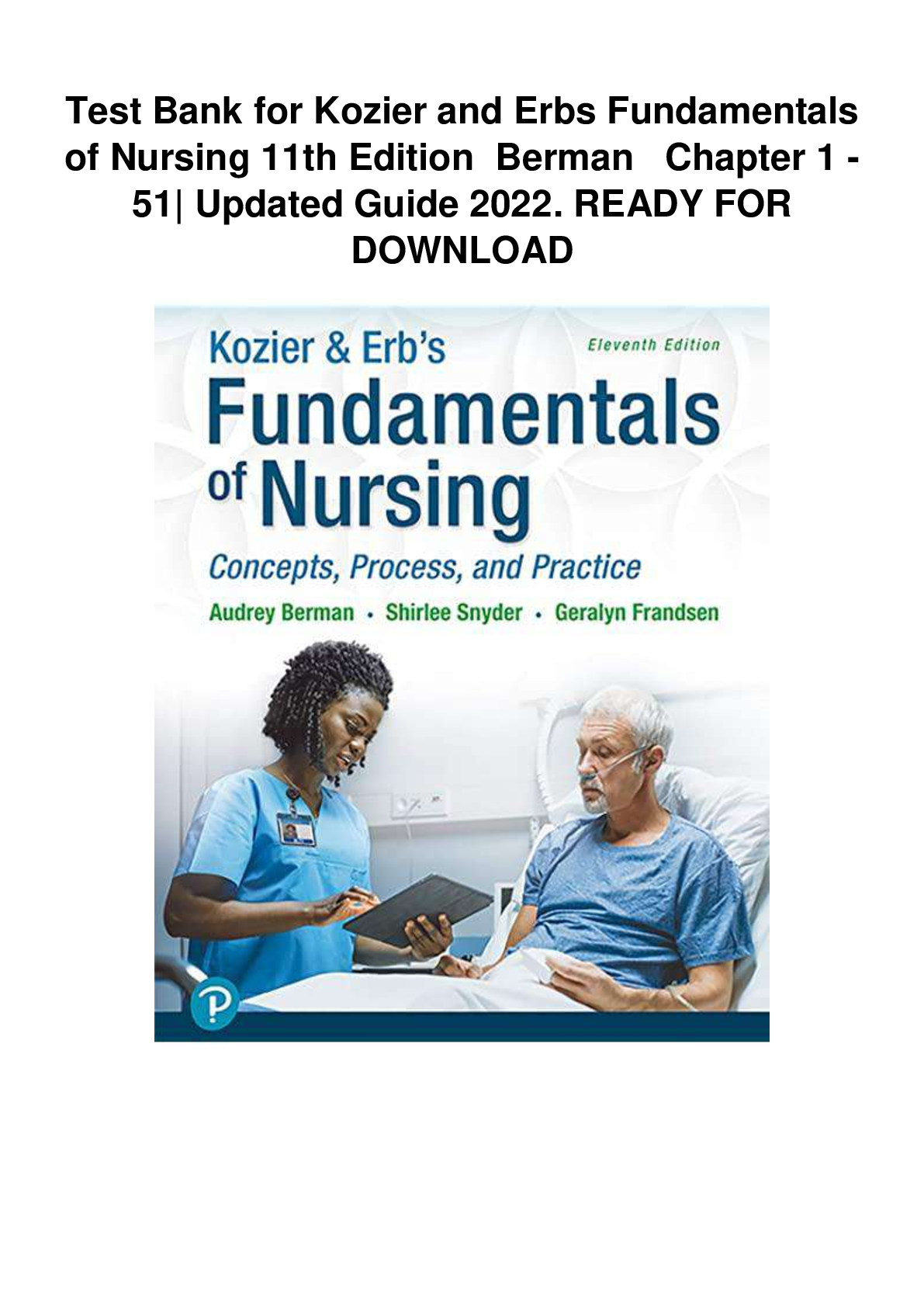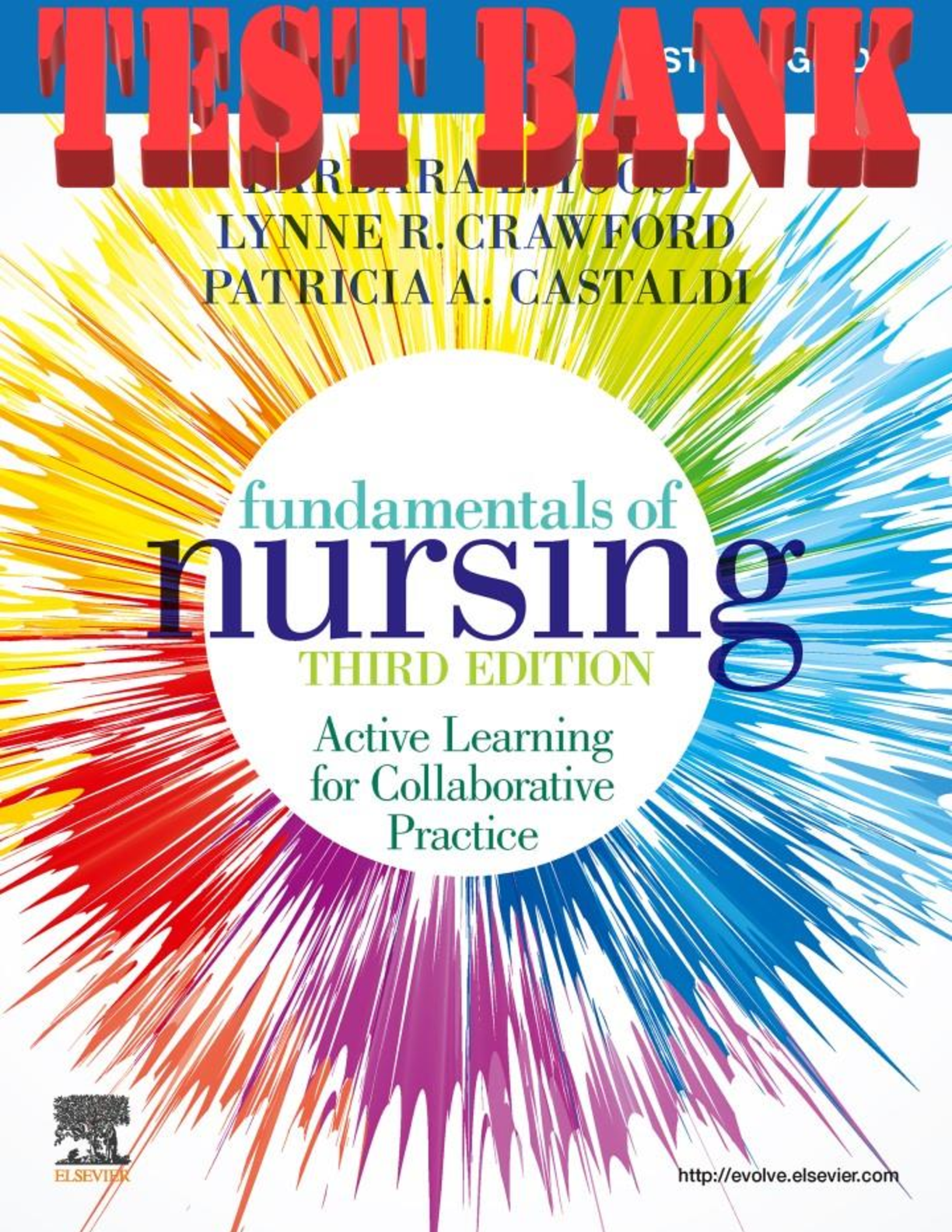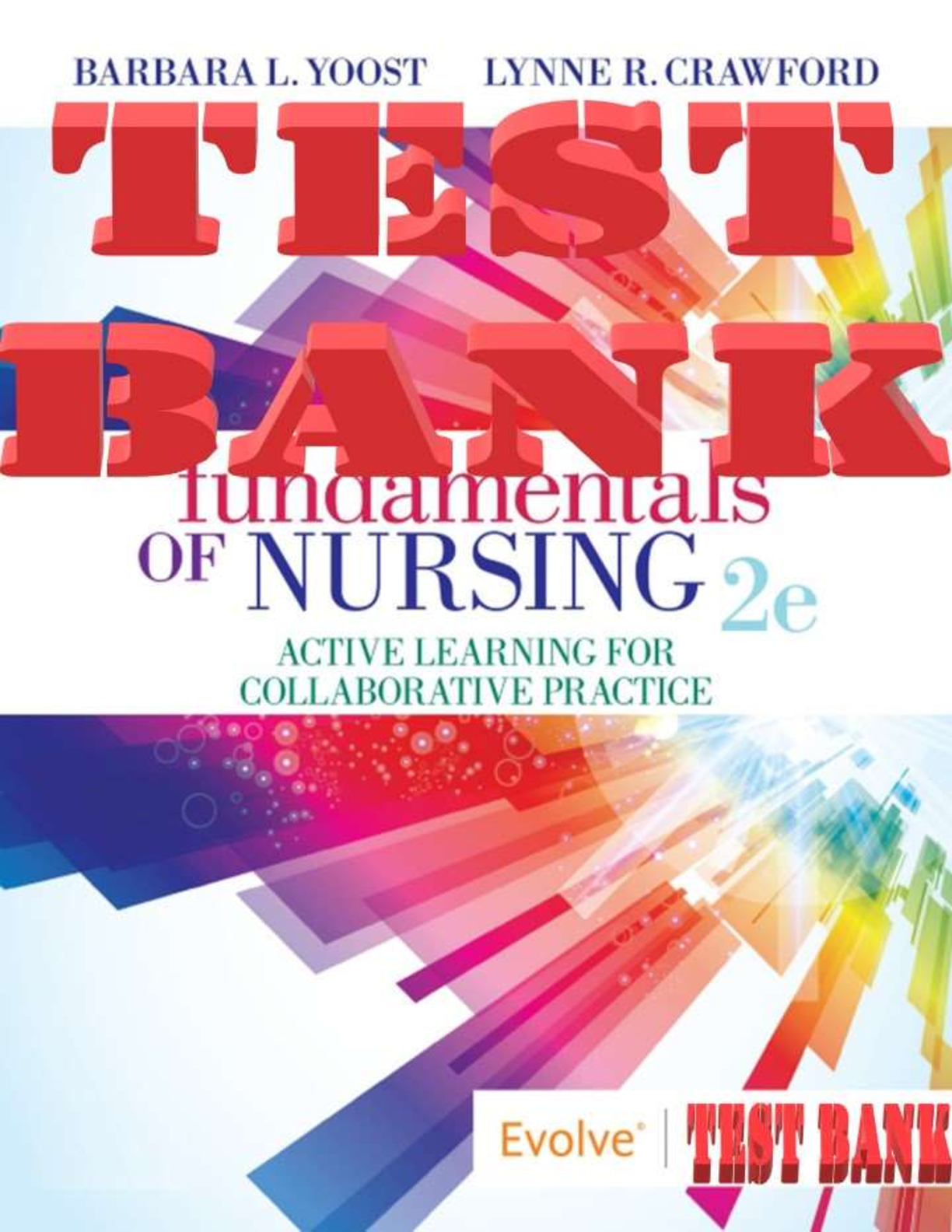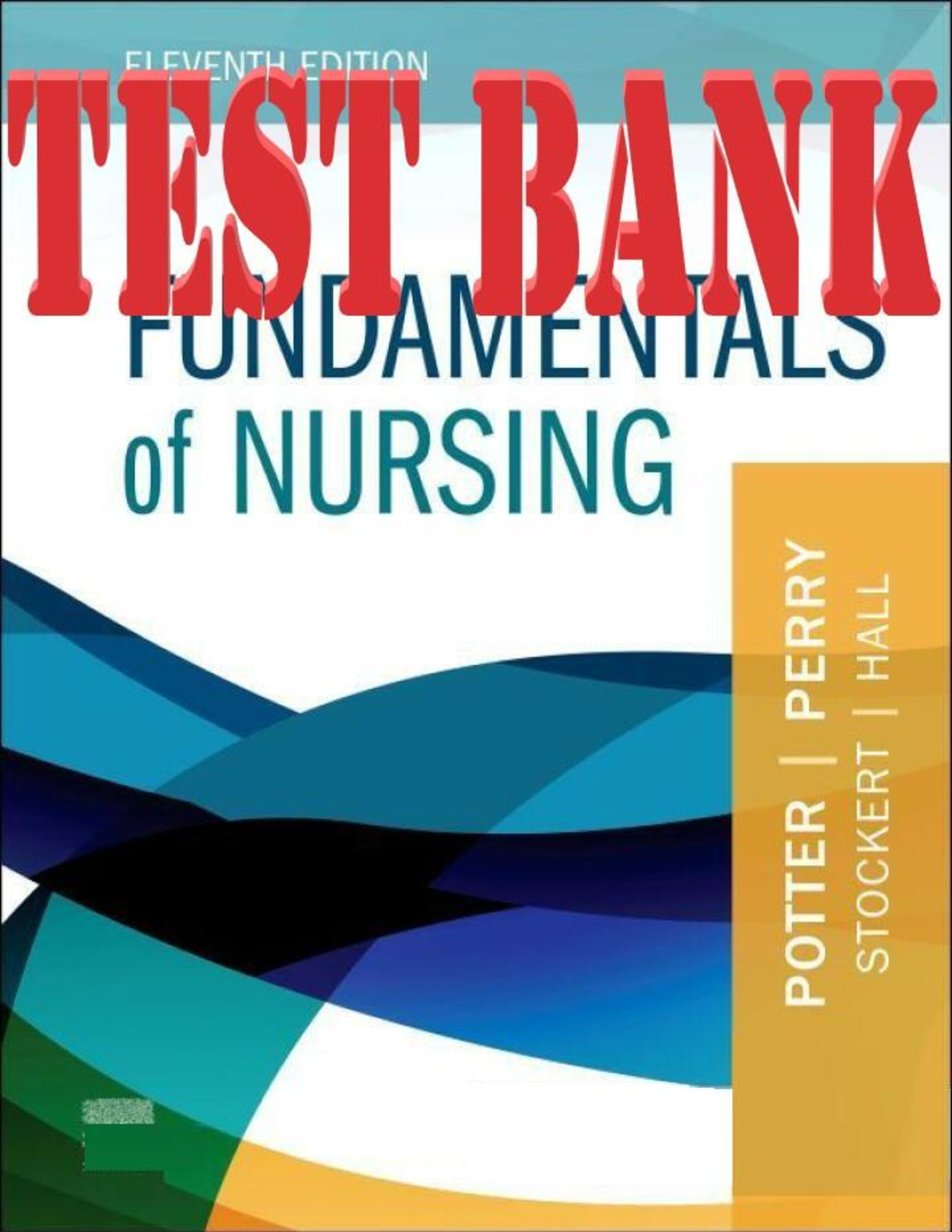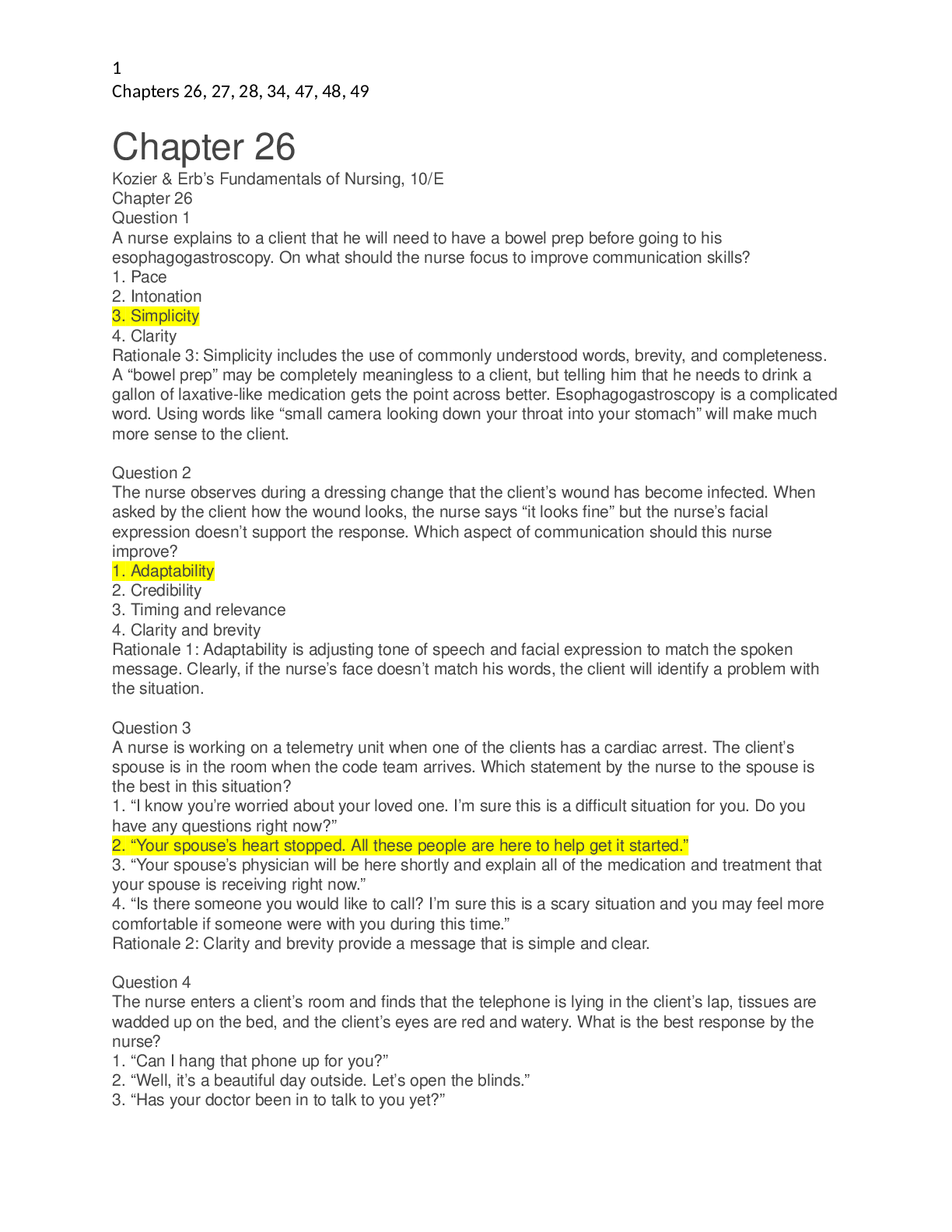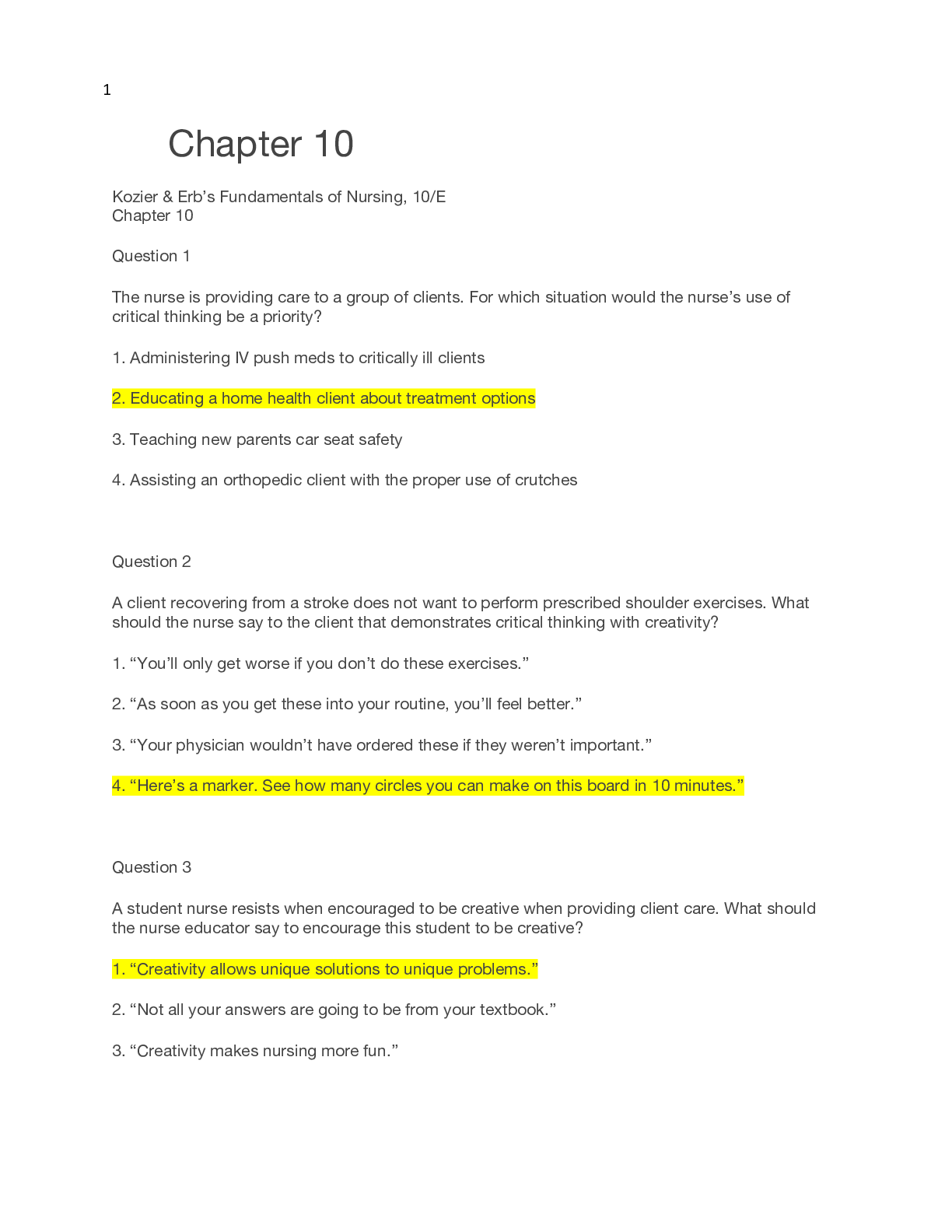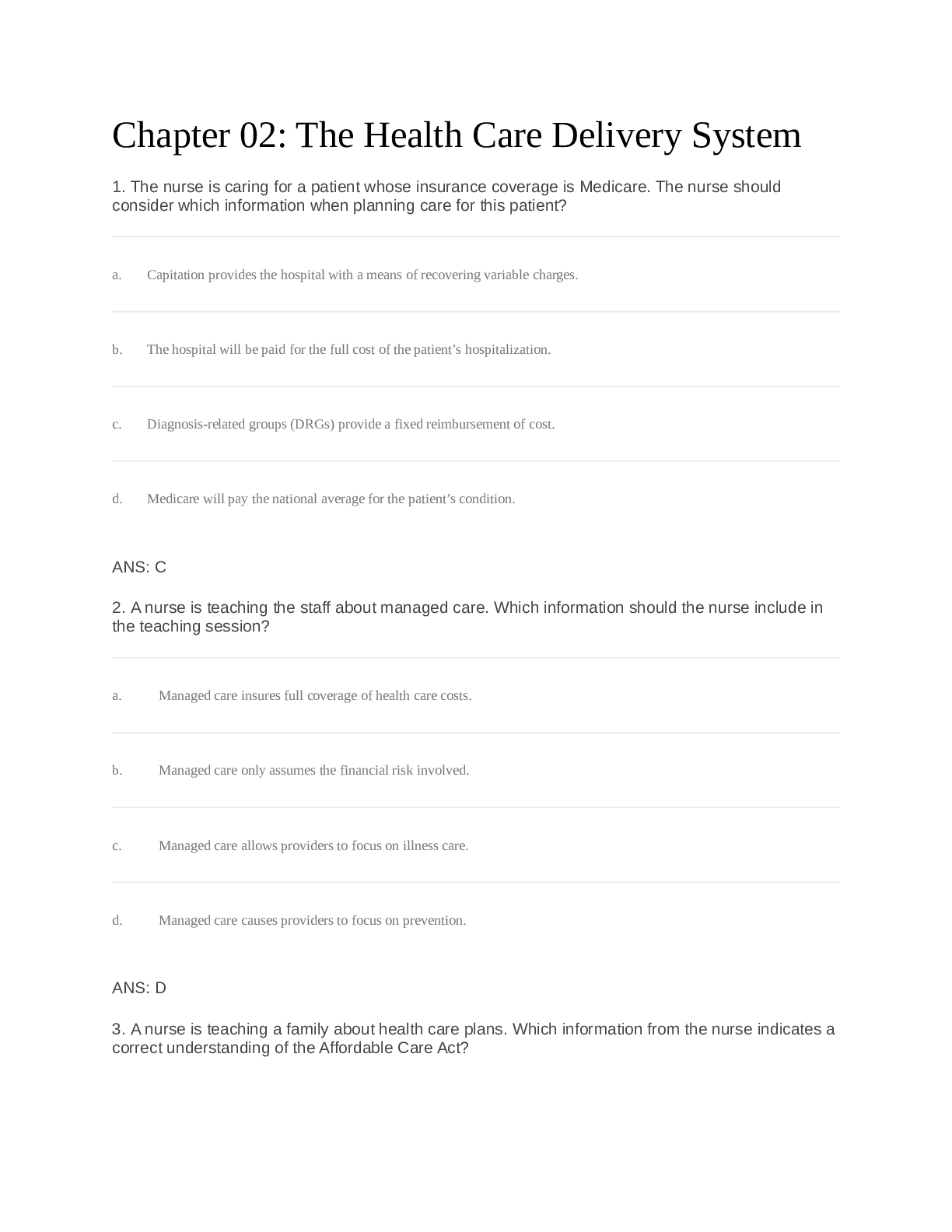*NURSING > TEST BANK > RNSG 1144 Fundamentals of Nursing 10th Edition (UPDATED) Test Bank | RNSG1144 Fundamentals of Nursin (All)
RNSG 1144 Fundamentals of Nursing 10th Edition (UPDATED) Test Bank | RNSG1144 Fundamentals of Nursing 10th Edition (UPDATED)
Document Content and Description Below
RNSG 1144 Fundamentals of Nursing 10th Edition (UPDATED) Test Bank RNSG 1144 Fundamentals of Nursing 10th Edition Fundamentals of Nursing 10th Edition (UPDATED) Test Bank 1800+ Pages of questions a... nd multiple choice answers Chapter 1. Nursing Today MULTIPLE CHOICE 1. Contemporary nursing practice is based on knowledge generated through nursing theories. Florence Nightingales theory introduced the concept that nursing care focuses on: 1 Psychological needs 2 A maximal level of wellness 3 Health maintenance and restoration 4 Interpersonal interactions with the client ANS: 3 Florence Nightingale believed the role of the nurse was to put the clients body in the best state in order to remain free of disease or to recover from disease. Although Florence Nightingale may have addressed meeting the psychological needs of her clients, it is not the focus of her theory. The goal of Nightingales theory is to facilitate the bodys reparative processes by manipulating the clients environment. Florence Nightingale thought the human body had reparative properties of its own if it was cared for in a way to recover from disease. Her theory did not focus on achieving a maximal level of wellness. Florence Nightingale believed the nurse was in charge of the clients health. Although she interacted with her clients by reading to them, her theory of nursing care did not focus upon interpersonal interactions. DIF: A REF: 2 OBJ: Knowledge TOP: Nursing Process: Assessment MSC: NCLEX test plan designation: Safe, Effective Care Environment/Coordinated Care 2. Nursing education programs in the United States may seek voluntary accreditation by the appropriate accrediting commission council of the: 1 National League for Nursing 2 American Nurses Association 3 Congress for Nursing Practice 4 International Council of Nurses ANS: 1 The National League for Nursing (NLN) is the professional nursing organization concerned with nursing education. The NLN provides accreditation to nursing programs that seek and meet the NLN accreditation requirements. The American Nurses Association (ANA) is concerned with the nursing profession and issues affecting health care, including standards of care. The Congress for Nursing Practice is the part of the ANA concerned with determining the legal aspects of nursing practice, the public recognition of the importance of nursing, and the impact of trends in health care on nursing practice. The International Council of Nurses (ICN) is concerned about issues of health care and the nursing profession, including the provision of an international power base for nurses. DIF: A REF: 8 OBJ: Knowledge TOP: Nursing Process: Assessment MSC: NCLEX test plan designation: Safe, Effective Care Environment/Coordinated Care 3. The minimum educational requirement for a nurse practitioner is: 1 Diploma in nursing 2 Masters in nursing 3 Doctorate in nursing 4 Baccalaureate in nursing ANS: 2 A masters degree is nursing is required to become a nurse practitioner. Diploma programs in nursing require 3 years of education after which the graduate may become a registered nurse, but not a nurse practitioner. Doctoral programs focus on the application of research findings to clinical practice. The doctoral degree is beyond the masters degree. The baccalaureate degree program generally requires 4 years of study in a college or university, after which the graduate may become a registered nurse, not a nurse practitioner. DIF: A REF: 8 OBJ: Knowledge TOP: Nursing Process: Assessment MSC: NCLEX test plan designation: Safe, Effective Care Environment/Coordinated Care 4. A group that lobbies at the state and federal level for advancement of nursings role, economic interest, and health care is the: 1 State Board of Nursing 2 American Nurses Association 3 American Hospital Association 4 National Student Nurses Association ANS: 2 The American Nurses Association (ANA) hires lobbyists at the state and federal level to promote the advancement of health care and the economic and general welfare of nurses. State Boards of Nursing primarily focus on licensure of nurses within their own state. The American Hospital Association does not focus on nurses economic issues and the advancement of the role of nurses. The National Student Nurses Association focuses on issues of importance for nursing students. DIF: A REF: 8 OBJ: Comprehension TOP: Nursing Process: Assessment MSC: NCLEX test plan designation: Safe, Effective Care Environment/Coordinated Care 5. A nurse moves from Seattle to Boston and begins working in a hospital. The most important factor for the nurse to consider when moving to another state is the: 1 Massachusetts Nurse Practice Act 2 Standard for nursing practice in Boston 3 Clinical ladder of mobility in the new hospital 4 Requirement for continuing education units (CEU) in Massachusetts ANS: 1 Although most states have similar practice acts, each individual state has its own Nurse Practice Act that regulates the licensure and practice of nursing within that state. Knowledge of the Nurse Practice Act is necessary to provide safe and legal nursing care. Standards of nursing practice are not specific to a city, but rather to the profession itself. Although the clinical ladder of mobility may be of interest in regard to professional advancement, it is not the most important factor when practicing nursing in another state. Knowledge of the Nurse Practice Act in order to provide safe and legal nursing care is of higher importance. Regardless of where a nurse practices, the nurse should strive to remain current. DIF: C REF: 8 OBJ: Analysis TOP: Nursing Process: Assessment MSC: NCLEX test plan designation: Safe, Effective Care Environment/Coordinated Care 6. A nurse is caring for a client who has chronic renal failure. The nurse states, We will do everything possible to return you to the optimum level of self-care possible. In coordinating an approach to best meet the needs of this client, the nurse is fulfilling the role of: 1 Manager 2 Educator 3 Counselor 4 Communicator ANS: 1 The nurse, in caring for this client, will coordinate the activities of other members of the health care team. This client may require the assistance of a nursing assistant to provide personal care until the client is less fatigued. A nutritionist may be necessary for diet evaluation, planning, and teaching. A nurse may provide education on the dialysis therapy and perform the skill necessary until the client is able to do so independently. The nurse may include patient teaching in the clients care, but more is required to meet the needs of this client. The nurse is not performing in the role of counselor. Clear communication will be necessary for the client to understand self-care measures regarding dialysis. The role of communicator does not, however, entirely meet the clients physical needs at this time. DIF: A REF: 10 OBJ: Comprehension TOP: Nursing Process: Planning MSC: NCLEX test plan designation: Safe, Effective Care Environment/Coordinated Care 7. Nurses have the opportunity to work in a wide variety of health care agencies around the world. The practice setting where the majority of nurses continue to work is: 1 Acute care 2 Home care 3 Long-term care 4 Ambulatory care ANS: 1 Most nurses provide direct client care in the hospital setting. Although opportunities for providing patient care in the clients home are increasing, the majority of nurses are not employed in this setting. The majority of nurses do not work in nursing homes or extended care settings. Significantly fewer nurses work in an ambulatory care setting. DIF: A REF: 10 OBJ: Knowledge TOP: Nursing Process: Assessment MSC: NCLEX test plan designation: Safe, Effective Care Environment/Coordinated Care 8. A client is receiving Dilantin to prevent seizure activity. To which allied health care professional should the nurse refer this client in order to minimize the challenges this condition creates? 1 Physical therapist 2 Physicians assistant 3 Respiratory therapist 4 Occupational therapist ANS: 4 An occupational therapist is a person who provides assessment and intervention to ameliorate physical and psychological deficits that interfere with the performance of activities and tasks of living, including ones employment. A physical therapist is responsible for the patients musculoskeletal system. A physical therapist may use exercises as an intervention to improve a clients mobility. A respiratory therapist provides treatment to preserve or improve pulmonary function. A physicians assistant performs tasks usually done by physicians and works under the direction of a supervising physician. DIF: C OBJ: Analysis TOP: Nursing Process: Planning MSC: NCLEX test plan designation: Safe, Effective Care Environment/Coordinated Care 9. The Goldmark Report concluded that: 1 Nursing roles and responsibilities required clarification 2 A theory-based curriculum was necessary for accreditation 3 Nursing education programs must be affiliated with universities 4 Increased financial support should be provided for nursing education ANS: 4 In 1923 the Goldmark Report identified the need for increased financial support to university- based schools of nursing. The National Commission on Nursing and Nursing Education Report of 1965 recommended that nursing roles and responsibilities be clarified in relation to other health care professionals. In 1975 the National League for Nursing required theory-based curriculum for accreditation. The Brown Report of 1948 concluded that all nursing education programs should be affiliated with universities and should have their own budgets. DIF: A REF: 3 OBJ: Knowledge TOP: Nursing Process: Assessment MSC: NCLEX test plan designation: Safe, Effective Care Environment/Coordinated Care 10. In 1893 Lillian Wald and Mary Brewster made significant contributions to the nursing profession through their work involving the: 1 Henry Street Settlement in New York 2 First training school in Toronto, Canada 3 Training school at Johns Hopkins in Baltimore 4 Development of the American Journal of Nursing ANS: 1 In 1893 Lillian Wald and Mary Brewster opened the Henry Street Settlement, which was the first community health service for the poor. The first nurses training school in Canada was founded in St. Catherines, Ontario, in 1874. In 1894 Isabel Hampton Robb was the first superintendent of the Johns Hopkins Training School in Baltimore, Maryland. Isabel Hampton Robb was one of the original founders of the American Journal of Nursing. DIF: A REF: 3 OBJ: Comprehension TOP: Nursing Process: Assessment MSC: NCLEX test plan designation: Safe, Effective Care Environment/Coordinated Care 11. To obtain a certification in a specialty area, the nurse will have to complete: 1 A request for state approval 2 A graduate degree in nursing 3 An examination and the minimum practice requirements 4 A general examination given to all nurses seeking certification ANS: 3 Set minimum practice requirements are based on the certification the nurse is seeking. After passing the initial examination, the nurse maintains certification by ongoing continuing education and clinical or administrative practice. Individual states do not grant certification by request. Certification in a specialty area requires passing the examination for certification in that area and meeting minimum practice requirements. A masters degree in nursing is not required for certification in a specialty area. A specialized examination is given according to the specific area of nursing practice in which certification is being sought. DIF: A REF: 9 OBJ: Knowledge TOP: Nursing Process: Assessment MSC: NCLEX test plan designation: Safe, Effective Care Environment/Coordinated Care 12. In the ANA Standards of Professional Performance, which one of the following is a specific measurement criterion for The nurses decisions and actions on behalf of clients are determined in an ethical manner? 1 Acts as client advocate 2 Participates in the collection of client data 3 Seeks experiences to maintain clinical skills 4 Consults with appropriate health care providers ANS: 1 As a client advocate, the nurse protects the clients human and legal rights and provides assistance in asserting those rights if the need arises. Performing in the role of patient advocate fulfills a measurement criterion for the professional performance standard of ethics. Participating in data collection is a measurement criterion for the professional performance standard of quality of practice. The nurse who seeks experiences to maintain clinical skills is fulfilling a measurement criterion for the professional performance standard of education. Consulting with health care providers is a measurement criterion for the professional performance standard of collaboration. DIF: A REF: 7 OBJ: Comprehension TOP: Nursing Process: Assessment MSC: NCLEX test plan designation: Safe, Effective Care Environment/Coordinated Care 13. In looking at the nineteenth century, the growth of professional nursing was stimulated by: 1 The Civil War 2 Federal legislation 3 Florence Nightingale 4 The womens suffrage movement ANS: 1 The Civil War stimulated the growth of nursing in the United States. Nurses were in demand to tend to the soldiers of the battlefield. Throughout history, nurses and their professional organizations have lobbied for health care legislation to meet the needs of clients. However, legislation was not responsible for the growth of nursing in the nineteenth century. Although Florence Nightingale had great impact on the practice of nursing, she was not the cause for the growth of nursing in the United States during the nineteenth century. The womens movement has encouraged nurses to seek greater autonomy and responsibility in providing care, and has caused female clients to seek more control of their health and lives. The womens movement was not responsible for the growth of nursing in the nineteenth century. DIF: A REF: 3 OBJ: Comprehension TOP: Nursing Process: Assessment MSC: NCLEX test plan designation: Safe, Effective Care Environment/Coordinated Care 14. Which of the following educational activities is an example of in-service education? 1 A workshop given at a nursing convention on malpractice 2 A program on new cardiac medications provided at a local hospital 3 Credit courses in communication offered at the community college 4 Noncredit courses on nursing issues available through the internet ANS: 2 An in-service education program is instruction or training provided by a health care agency or institution for its employees. A workshop at a nursing convention is an example of a continuing education program. Credit courses at a college are examples of continuing education that could possibly by applied toward furthering ones degree. Noncredit courses offered via the internet are an example of a continuing education program. DIF: A REF: 8 OBJ: Comprehension TOP: Nursing Process: Assessment MSC: NCLEX test plan designation: Safe, Effective Care Environment/Coordinated Care 15. Nurses need to be aware of current trends in the health care delivery system in order to respond in educational preparation and practice. A major trend that is influencing nursing practice today is: 1 Decreased client acuity 2 Increased hospital stays 3 Decreased emphasis on health promotion 4 Increased incidence of chronic disease processes ANS: 4 In recent decades, there is a higher incidence of chronic, long-term illness. With shortened hospital stays, client acuity has increased, not decreased. Hospital stays have decreased, not increased. Lengths of stay have shortened with a trend toward home care, and health promotion and illness prevention. With increased public awareness and rising health care costs, greater emphasis has been placed on health promotion and illness prevention. DIF: A REF: 4 OBJ: Comprehension TOP: Nursing Process: Assessment MSC: NCLEX test plan designation: Safe, Effective Care Environment/Coordinated Care 16. The nurse assists the client in a health promotion activity that also reduces the cost of health care delivery when: 1 Administering medication 2 Treating a diabetic foot ulcer 3 Obtaining an operative consent 4 Discussing exercise and nutrition ANS: 4 The nurse may educate the client in such areas as exercise, nutrition, and healthy lifestyles to assist the client in health promotion and illness prevention. By administering medication, the nurse is assisting to restore a person to health or maintain ones health. A nurse who treats a foot ulcer is assisting a client to restore their health, rather than promoting healthy behaviors. Obtaining an operative consent pertains to legal aspects of care and is not considered a health promotion activity. DIF: A REF: 5 OBJ: Comprehension TOP: Nursing Process: Planning MSC: NCLEX test plan designation: Health Promotion and Maintenance/Programs 17. The nurse is best able to provide quality care that benefits both client and family by: 1 Incorporating caring into the practice 2 Making the client the center of the practice 3 Integrating the science and art of nursing into the practice 4 Being knowledgeable of the institutions standards of practice ANS: 3 Nursing is an art and a science. As a professional nurse you will learn to deliver care artfully with compassion, caring, and a respect for each clients dignity and personhood. As a science, nursing is based on a body of knowledge that is continually changing with new discoveries and innovations. When you integrate the science and art of nursing into your practice, the quality of care you provide to your clients is at a level of excellence that benefits clients and their families. Caring is one part of the art of nursing. While the client is the focus of nursing practice, this focus is not the main contributor to quality care. Standards of care provide guidelines for the delivery of client care. Awareness of the standards does not guarantee quality care. DIF: C REF: 2 OBJ: Analysis TOP: Nursing Process: Assessment MSC: NCLEX test plan designation: Safe, Effective Care Environment/Coordinated Care 18. Which of the following statements best reflects Nightingales nursing philosophy on health maintenance and restoration? 1 Did all the clients eat a good breakfast? 2 What is the client rating his pain level after his medication? 3 Have any clients developed a nosocomial infection last month? 4 Is anyone interested in volunteering to mentor our new graduates? ANS: 3 Florence Nightingale studied and implemented methods to improve battlefield sanitation, which ultimately reduced illness, infection, and mortality (Cohen, 1984). Today nurses are active in determining the best practices for skin care management, pain control, nutritional management, and care of older adults. Infection control and its impact on disease prevention was a major outcome of her contributions to nursing. Awareness of the connection between hospital-acquired infections (nosocomial) and nursing practice is the best example of her nursing philosophy. Nutritional management and its impact on client health, while important does not reflect the best option offered. Pain management while a vital client concern does not represent the best option offered While volunteering is certainly reflected in Nightingales practice it is not the best option offered. DIF: C REF: 2-3 OBJ: Analysis TOP: Nursing Process: Assessment MSC: NCLEX test plan designation: Health Promotion and Maintenance/Disease Prevention 19. The twentieth century is recognized for which of the following nursing concepts? 1 Code of Nursing Ethics 2 Hospital-based nursing care 3 Specialized nursing textbooks were adopted. 4 Formalized university-based nursing education ANS: 4 In the early twentieth century a movement toward a scientific, research-based defined body of nursing knowledge and practice was evolving. Nurses began to assume expanded and advanced practice roles. Mary Adelaide Nutting was instrumental in the affiliation of nursing education with universities. In 1990 the American Nurses Association established the Center for Ethics and Human Rights. Nursing in hospitals expanded in the late nineteenth century. Isabel Hampton Robb helped found the Nurses Associated Alumnae of the United States and Canada in 1896. This organization became the American Nurses Association (ANA) in 1911. She authored many nursing textbooks, including Nursing: Its Principles and Practice for Hospital and Private Use (1894), Nursing Ethics (1900), and Educational Standards for Nurses (1907), and was one of the original founders of theAmerican Journal of Nursing (AJN). DIF: A REF: 4 OBJ: Comprehension TOP: Nursing Process: Assessment MSC: NCLEX test plan designation: Safe, Effective Care Environment 20. The best example of the impact of the womens movement on health care is: 1 Improvement in breast cancer survival rates 2 Insurance coverage for well-woman check-ups 3 Women subjects to be included in all appropriate health research projects 4 A single, teenage mother receiving Women, Infants, and Children (WIC) benefits ANS: 3 The womens movement brought about many changes in society as women increasingly demanded economic, political, occupational, and educational equality. As a result, there is greater sensitivity to the health care needs of women and the role of women in health care research. There are emerging health care specialties dealing with the needs of women. These new specialties expand from the traditional obstetrical specialty and address issues ranging from well- womens examinations, to oncological subspecialties, to the management of menopause. Because of the prior lack of female subjects in biomedical research, the federal government now requires studies to routinely include women in research, unless specific exception criteria are met. For example, research focusing on management of prostatic cancer is an exception. Improved survival rates for female-oriented cancers is evident because of emphasis being placed on research. While important, increased insurance coverage is not the best option available because this action would be directly driven by research findings. While important, increased federal funding for female-oriented benefits does not represent the best option available because this action would be directly driven by research findings. DIF: C REF: 4 OBJ: Analysis TOP: Nursing Process: Comprehension MSC: NCLEX test plan designation: Health Promotion and Maintenance - - - - - - - - - - - - - - - - - - - - - - - - - - - - - MSC: NCLEX test plan designation: Physiological Integrity/Physiological Adaptation/ Alterations in Body Systems 1. A client with a suspected narcotic (heroin) overdose is brought to the emergency department by the police. The nurse anticipates that assessment findings will reveal: 1 Agitation 2 Hyperpnea 3 Restlessness 4 Decreased level of consciousness ANS: 4 With a narcotic overdose, the respiratory center is depressed, reducing the rate and depth of respiration and the amount of inhaled oxygen. The client may display signs of hypoventilation, such as a decreased level of consciousness. A narcotic (heroin) overdose would cause sedation and respiratory depression, not agitation. The client would experience bradypnea, not hyperpnea. A narcotic (heroin) overdose would cause sedation and respiratory depression, not restlessness. DIF: A REF: 916 OBJ: Comprehension TOP: Nursing Process: Assessment MSC: NCLEX test plan designation: Physiological Integrity/Physiological Adaptation/ Alterations in Body Systems 2. The nurse identifies that the client is unable to cough to produce a sputum specimen, and the clients secretions must be suctioned. Which suctioning route is preferred for obtaining this specimen? 1 Nasopharyngeal 2 Nasotracheal 3 Oropharyngeal 4 Orotracheal ANS: 2 Nasotracheal suctioning is the preferred route for obtaining a sputum specimen when the client is unable to cough to produce a sputum specimen on his or her own. The nasopharyngeal route for suctioning is used when the client is able to cough but is unable to clear secretions by expectorating or swallowing. It is not the preferred route for obtaining a sputum specimen. The oropharyngeal route is used when the client is able to cough but is unable to clear secretions by expectorating or swallowing. It is not the preferred route for obtaining a sputum specimen. The orotracheal route is used when the client is unable to manage secretions by coughing. The nasotracheal route is preferred over the orotracheal route because stimulation of the gag reflex is minimal. DIF: A REF: 931 OBJ: Comprehension TOP: Nursing Process: Planning MSC: NCLEX test plan designation: Physiological Integrity/Physiological Adaptation/ Alterations in Body Systems 3. The nurse is checking the clients overall oxygenation. In assessment of the presence of central cyanosis, the nurse will inspect the clients: 1 Palms and soles of the feet 2 Nail beds 3 Earlobes 4 Tongue ANS: 4 Central cyanosis is observed in the tongue, soft palate, and conjunctiva of the eye, where blood flow is high. Central cyanosis indicates hypoxemia. Peripheral cyanosis seen in the palms and soles of the feet, nail beds, or earlobes is often a result of vasoconstriction and stagnant blood flow. DIF: A REF: 917 OBJ: Comprehension TOP: Nursing Process: Assessment MSC: NCLEX test plan designation: Physiological Integrity/Physiological Adaptation/ Alterations in Body Systems 4. A client has recently had mitral valve replacement surgery. To prevent excess serosanguineous fluid buildup, the nurse anticipates that care will include: 1 Increased oxygen therapy 2 Frequent chest physiotherapy 3 Incentive spirometry on a regularly scheduled basis 4 Chest tube placement in the thoracic cavity ANS: 4 Chest tubes are inserted to remove air and fluids from the pleural space, to prevent air or fluid from reentering the pleural space, and to reestablish normal intrapleural and intrapulmonic pressures. The client who had mitral valve replacement surgery would be expected to have a chest tube postoperatively to prevent excess fluid buildup in the pleural space. Increased oxygen will not prevent excess fluid buildup. Frequent chest physiotherapy may help facilitate removal of secretions but will not prevent excess fluid buildup. Incentive spirometry is used to promote deep breathing and to prevent or treat atelectasis in the postoperative client. It will not prevent excess fluid buildup. DIF: A REF: 950 OBJ: Comprehension TOP: Nursing Process: Planning MSC: NCLEX test plan designation: Physiological Integrity/Physiological Adaptation/ Alterations in Body Systems 5. The client is admitted to the emergency department with a pneumothorax. The nurse anticipates that the client will be experiencing: 1 Dyspnea 2 Eupnea 3 Fremitus 4 Orthopnea ANS: 1 The client with a pneumothorax (collapsed lung) will exhibit dyspnea and pain. Eupnea is normal, easy breathing. It would not be expected in the case of a pneumothorax. Fremitus is the vibration felt when the hand is placed on the clients chest and the client speaks (vocal fremitus). Fremitus would be decreased with a pneumothorax. Orthopnea is a condition in which the person must use multiple pillows when lying down or must sit with the arms elevated and leaning forward to breathe. The client with a pneumothorax would be exhibiting dyspnea. DIF: A REF: 951 OBJ: Comprehension TOP: Nursing Process: Assessment MSC: NCLEX test plan designation: Physiological Integrity/Physiological Adaptation/ Alterations in Body Systems 6. The client with a chronic obstructive respiratory disease is receiving oxygen via a nasal cannula. Which of the following interventions does the nurse plan to include in the clients care? 1 Assess nares for skin breakdown every 6 hours. 2 Check patency of the cannula every 2 hours. 3 Inspect the mouth every 6 hours. 4 Check oxygen flow every 24 hours. ANS: 1 The nurse caring for the client with a nasal cannula should plan to assess the clients nares and superior surface of both ears for skin breakdown every 6 hours. The nurse should check patency of the cannula every 8 hours. The nurse does not need to check the clients mouth in relation to the clients use of a nasal cannula. The nurse should continue providing oral hygiene and may assess the mouth (i.e., tongue) for cyanosis, along with other assessment measures. Oxygen flow should be checked every 8 hours, not every 24 hours. DIF: A REF: 957 OBJ: Comprehension TOP: Nursing Process: Planning MSC: NCLEX test plan designation: Physiological Integrity/Physiological Adaptation/ Alterations in Body Systems 7. All of the following clients are experiencing increased respiratory secretions and require intervention to assist in their removal. Chest percussion is indicated and appropriate for the client experiencing: 1 Thrombocytopenia 2 Cystic fibrosis 3 Osteoporosis 4 Spinal fracture ANS: 2 Chest percussion is indicated and appropriate for the client with cystic fibrosis to assist in mobilizing the thick pulmonary secretions. Percussion is contraindicated in clients with bleeding disorders, such as the client with thrombocytopenia. Percussion is also contraindicated in the client with osteoporosis and the client with a spinal fracture or with fractured ribs. DIF: A REF: 931 OBJ: Comprehension TOP: Nursing Process: Assessment MSC: NCLEX test plan designation: Physiological Integrity/Physiological Adaptation/ Alterations in Body Systems 8. The nurse is working on a pulmonary unit at the local hospital. The nurse is alert to one of the early signs of hypoxia in the clients, which is: 1 Cyanosis 2 Restlessness 3 A decreased respiratory rate 4 A decreased blood pressure ANS: 2 Mental status changes are often the first signs of respiratory problems and may include restlessness and irritability. Cyanosis is a late sign of hypoxia. A decreased respiratory rate is not an early sign of hypoxia. The respiratory rate will increase as the body attempts to compensate for the decreased level of oxygen. As the hypoxia worsens, the respiratory rate may decline. During early stages of hypoxia the blood pressure is elevated unless the condition is caused by shock. DIF: A REF: 916 OBJ: Comprehension TOP: Nursing Process: Assessment MSC: NCLEX test plan designation: Physiological Integrity/Physiological Adaptation/ Alterations in Body Systems 9. It is suspected that the clients oxygenation status is deteriorating. The nurse is aware that the abnormal assessment finding that represents the most serious indication of the clients decreased oxygenation is: 1 Poor skin turgor 2 Clubbing of the nails 3 Central cyanosis 4 Pursed-lip breathing ANS: 3 Central cyanosis is the most serious finding because it indicates hypoxemia. Poor skin turgor indicates dehydration. It is not an indication of the clients decreased oxygenation. Clubbing of the nails is found in clients with prolonged oxygen deficiency, endocarditis, and congenital heart defects. It is a change that occurs over time and is not an indication of the clients current deterioration in oxygenation status. Pursed-lip breathing is used to slow expiratory flow. It is not the most serious indication of a clients decreased oxygenation. DIF: C REF: 917 OBJ: Analysis TOP: Nursing Process: Assessment MSC: NCLEX test plan designation: Physiological Integrity/Physiological Adaptation/ Alterations in Body Systems 10. In teaching a client about an upcoming diagnostic test, the nurse identifies that which one of the following uses an injection of contrast material? 1 Holter monitor 2 Echocardiography 3 Cardiac catheterization 4 Exercise stress test ANS: 3 A cardiac catheterization involves the injection of contrast material in order to visualize the cardiac chambers, valves, the great vessels, and coronary arteries. It also is used to measure the pressures and volumes within the chambers of the heart. A Holter monitor is a portable ECG worn by the client. It does not require contrast media. An echocardiography is a noninvasive measure that graphically depicts overall cardiac performance. An exercise stress test evaluates the cardiac response to the physical stress of the client on a treadmill. Contrast material is not used for this test. DIF: A REF: 925 OBJ: Comprehension TOP: Nursing Process: Assessment MSC: NCLEX test plan designation: Physiological Integrity/Physiological Adaptation/ Alterations in Body Systems 11. At a community health fair the nurse informs the residents that the influenza vaccine is recommended for clients: 1 Only older than age 65 2 40 to 60 years of age 3 In any age-group who have a chronic disease 4 Who have an acute febrile illness ANS: 3 Annual influenza vaccine is recommended for clients of any age with a chronic disease. Annual influenza vaccine is recommended for clients older than age 65, but this is not the only group. Annual influenza vaccine is recommended for any age-group, including those age 40 to 60, who have a chronic disease of the heart, lung, or kidneys; clients with diabetes; clients with immunosuppression or severe forms of anemia; or those in close or frequent contact with anyone in a high-risk group. Clients with an acute febrile illness should not be vaccinated. DIF: A REF: 927 OBJ: Comprehension TOP: Nursing Process: Assessment MSC: NCLEX test plan designation: Physiological Integrity/Physiological Adaptation/ Alterations in Body Systems 12. The unit manager is orienting a new staff nurse and evaluates which of the following as an appropriate technique for nasotracheal suctioning? 1 Placing the client in a supine position 2 Preparing for a clean or nonsterile technique 3 Suctioning the oropharyngeal area first, then the nasotracheal area 4 Applying intermittent suction for 10 seconds during catheter removal ANS: 4 Intermittent suction for up to 10 to 15 seconds should be applied during catheter removal to prevent injury to the mucosa. The client is not placed in a supine position. The client is usually placed in a semi-Fowlers position. The clients head is turned to the right to help the nurse suction the left mainstem bronchus, and the clients head is then turned to the left to help the nurse suction the right mainstem bronchus. Nasotracheal suctioning is a sterile procedure. The nasotracheal area should be suctioned first, then the oropharyngeal area. The mouth and pharynx contain more bacteria than the trachea. DIF: A REF: 931 OBJ: Comprehension TOP: Nursing Process: Planning MSC: NCLEX test plan designation: Physiological Integrity/Physiological Adaptation/ Alterations in Body Systems 13. The client has chest tubes in place following thoracic surgery. In working with a client who has a chest tube, the nurse should: 1 Clamp the tubes except during client assessments 2 Remove the tubing from the connection to check for adequate suction power 3 Milk or strip the tubes every 15 to 30 minutes to maintain drainage 4 Coil and secure excess tubing next to the client ANS: 4 If the client is in a chair and the tubing is coiled, the tubing should be lifted every 15 minutes to promote drainage. Care should be taken to ensure the tubing remains secure. Clamping the tubes except during client assessments is an inaccurate statement. Clamping a chest tube is contraindicated when the client is ambulating or being transported. In a water-sealed system, gentle bubbling in the suction-control chamber indicates it is functioning. The suction source may be checked to verify it is on the appropriate setting. In a waterless system, the suction control (float ball) indicates the amount of suction the clients intrapleural space is receiving. The tubing should not be disconnected. The chest tube should be stripped or milked only if indicated (e.g., there is clotted drainage in the tube) (check institutional policy). It is believed that stripping the tube greatly increases intrapleural pressure, which could damage the pleural tissue and cause or worsen an existing pneumothorax. Milking causes less of a pressure change. DIF: A REF: 950 OBJ: Comprehension TOP: Nursing Process: Planning MSC: NCLEX test plan designation: Physiological Integrity/Physiological Adaptation/ Alterations in Body Systems 14. The client has supplemental oxygen in place and requires suctioning to remove excess secretions from the airway. To promote maximum oxygenation, an appropriate action by the nurse is to: 1 Suction continuously for 30-second intervals 2 Replace the oxygen and allow rest in between suctioning passes 3 Increase the amount of suction pressure to 200 mm Hg 4 Complete a number of suctioning passes until the catheter comes back clear ANS: 2 To promote maximum oxygenation, the nurse should replace the oxygen and allow rest in between suctioning passes. Suctioning should be intermittent for up to 10 to 15 seconds. Wall suction is set at 80 to 120 mm Hg; portable suction is set at 7 to 15 mm Hg for adults. Elevated pressure settings, such as 200 mm Hg, increase the risk for trauma to mucosa and can induce greater hypoxia. The number of suctioning passes is determined by client assessment and need. Repeated passes can remove oxygen and may induce laryngospasm. The client is not suctioned until the catheter comes back clear. DIF: A REF: 936 OBJ: Comprehension TOP: Nursing Process: Implementation MSC: NCLEX test plan designation: Physiological Integrity/Physiological Adaptation/ Alterations in Body Systems 15. A client with a chest tube in place is being transported via stretcher to another room closer to the nurses station. During the transport the collection unit bangs against the wall and breaks open. The nurse immediately: 1 Clamps the tube 2 Tells the client to hyperventilate 3 Raises the tubing above the clients chest level 4 Places the end of the tube in a container of sterile water ANS: 4 If the drainage unit is broken, the end of the chest tube can be quickly submerged in a container of sterile water to reestablish the seal. Clamping the chest tube may result in a tension pneumothorax. If the tubing becomes disconnected, the client should be instructed to exhale as much as possible and to cough. The client should not hyperventilate. Raising the tubing above the clients chest level will not help the situation. DIF: C REF: 950 OBJ: Analysis TOP: Nursing Process: Implementation MSC: NCLEX test plan designation: Physiological Integrity/Physiological Adaptation/ Alterations in Body Systems 16. The client is experiencing a sinus dysrhythmia with a pulse rate of 82 beats per minute. Upon entering the room, the nurse expects to find the client: 1 Extremely fatigued 2 Complaining of chest pain 3 Experiencing a fluttering sensation in the chest 4 Having no clinical signs based on the assessment ANS: 4 The nurse would expect to find the client experiencing a sinus dysrhythmia at a rate of 82 beats per minute to have no clinical symptoms. The client with atrial fibrillation may complain of fatigue. The client experiencing a sinus dysrhythmia would not be expected to complain of chest pain. The client with atrial fibrillation may complain of a fluttering sensation in the chest. DIF: A REF: 913 OBJ: Comprehension TOP: Nursing Process: Assessment MSC: NCLEX test plan designation: Physiological Integrity/Physiological Adaptation/ Alterations in Body Systems 17. The electrical activity of the clients heart is being continuously monitored while the client is on the coronary care unit. Suddenly the nurse finds that the client is experiencing ventricular fibrillation. The nurse will prepare to: 1 Administer atropine 2 Prepare for cardiopulmonary resuscitation (CPR) 3 Prepare the client for surgical placement of a pacemaker 4 Instruct the client to perform the Valsalva maneuver ANS: 2 The nurse should prepare for CPR for the client experiencing ventricular fibrillation. Atropine is used for sinus bradycardia with hypotension and decreased cardiac output. In this case, the nurse should prepare to administer CPR, not atropine. A pacemaker may be required for the client with sinus bradycardia. It is not the treatment for ventricular fibrillation. The Valsalva maneuver is used to treat supraventricular tachycardia, not ventricular fibrillation. DIF: B REF: 913 OBJ: Application TOP: Nursing Process: Implementation MSC: NCLEX test plan designation: Physiological Integrity/Physiological Adaptation/ Alterations in Body Systems 18. The client is admitted to the medical center with a diagnosis of right-sided heart failure. In assessment of this client, the nurse expects to find: 1 Dyspnea 2 Confusion 3 Dizziness 4 Peripheral edema ANS: 4 Peripheral edema is an expected assessment finding in the client diagnosed with right-sided heart failure. Dyspnea is an expected assessment finding in the client diagnosed with left-sided heart failure. Confusion is a symptom of hypoventilation. Dizziness is an expected assessment finding in the client experiencing hypoxia. DIF: A REF: 913 OBJ: Comprehension TOP: Nursing Process: Assessment MSC: NCLEX test plan designation: Physiological Integrity/Physiological Adaptation/ Alterations in Body Systems 19. The nurse is preparing to teach a group of adult women about the signs and symptoms of a myocardial infarction (heart attack). The nurse will include in the teaching plan the results of research that demonstrate women may experience specific symptoms, such as: 1 Visual difficulties 2 Epigastric pain 3 Loss of motor function unilaterally 4 Right scapular discomfort and stiffness ANS: 2 Epigastric pain is a symptom of a myocardial infarction in women. Visual disturbances, loss of motor function unilaterally, and right scapular discomfort and stiffness are not symptoms of a myocardial infarction in women. DIF: A REF: 916 OBJ: Comprehension TOP: Nursing Process: Planning MSC: NCLEX test plan designation: Physiological Integrity/Physiological Adaptation/ Alterations in Body Systems 20. The nurse is reviewing the results of the clients diagnostic testing. Of the following results, the finding that falls within expected or normal limits is: 1 Palpable, elevated hardened area around a tuberculosis skin testing site. 2 Sputum for culture and sensitivity identifies Mycobacterium tuberculosis 3 Presence of acid fast bacilli in sputum 4 Arterial oxygen tension (PaO2) of 95 mm Hg ANS: 4 A palpable, elevated, hardened area surrounding a tuberculosis skin testing site is indicative of an antigen-antibody reaction and is considered a positive skin test. Sputum for culture and sensitivity noted the presence of an organism and acid fast bacilli. Normal arterial oxygen tension (PaO2) ranges between 95-100 mmHg. DIF: A REF: 916 OBJ: Comprehension TOP: Nursing Process: Assessment MSC: NCLEX test plan designation: Physiological Integrity/Physiological Adaptation/ Alterations in Body Systems 21. The nurse is completing a physical examination for a client who is anemic. In assessing the clients eyes, a sign assessed by the nurse that is consistent with the diagnosis is: 1 Xanthelasma 2 Petechiae 3 Corneal arcus 4 Pale conjunctiva ANS: 4 Pale conjunctiva is an assessment finding consistent with the diagnosis of anemia. Xanthelasma is caused by hyperlipidemia. Petechiae appear on the skin in clients with platelet deficiency (thrombocytopenia). Petechiae on the conjunctivae is consistent with a fat embolus or bacterial endocarditis. Corneal arcus is caused by hyperlipidemia in young to middle-age adults. It is a normal finding in older adults with arcus senilis. DIF: A REF: 923 OBJ: Comprehension TOP: Nursing Process: Assessment MSC: NCLEX test plan designation: Physiological Integrity/Physiological Adaptation/ Alterations in Body Systems 22. Several nursing students are discussing cardiac conduction with their clinical instructor. When asked where a heart rate of 56 beats per minute most likely originates, the most informed student replies: 1 The atrioventricular (AV) node 2 The sinoatrial (SA) node 3 The Purkinje network 4 The bundle of His ANS: 1 The conduction system originates with the sinoatrial (SA) node, the pacemaker of the heart. The SA node is in the right atrium next to the entrance of the superior vena cava. Impulses are initiated at the SA node at an intrinsic rate between 60 and 100 beats per minute. The electrical impulses are transmitted through the atria along intraatrial pathways to the atrioventricular (AV) node. The AV node mediates impulses between the atria and the ventricles. The intrinsic rate of the normal AV node is between 40 and 60 beats per minute. The AV node assists atrial emptying by delaying the impulse before transmitting it through the bundle of His and the ventricular Purkinje network. The intrinsic rate of the bundle of His and the ventricular Purkinje network is between 20 and 40 beats per minute. DIF: A REF: 913 OBJ: Comprehension TOP: Nursing Process: Assessment MSC: NCLEX test plan designation: Physiological Integrity/Physiological Adaptation/ Alterations in Body Systems 23. A client asks the nurse, I was told that my heart is beating in normal sinus rhythm (NSR). What does that mean? The nurse replies most therapeutically when responding with which of the following? 1 Are you worried about how your heart is working? 2 It means your heart is working just the way it is supposed to work. 3 A damaged heart doesnt beat in normal sinus rhythm like yours does. 4 Each beat starts in the SA node and then causes the chambers to contract. ANS: 4 NSR implies that the impulse originates at the SA node and follows the normal sequence through the conduction system. DIF: C REF: 913 OBJ: Analysis TOP: Nursing Process: Planning MSC: NCLEX test plan designation: Physiological Integrity/Physiological Adaptation/ Alterations in Body Systems 24. When the nurse is reviewing a clients laboratory results, a low calcium level is noted. When the nurse then reviews the clients electrocardiogram, the most likely change noted will be a(n): 1 Increased Q-T interval 2 Increased P-R interval 3 Q-T interval less than 0.12 seconds 4 QRS interval greater than 0.12 seconds ANS: 1 The normal Q-T interval is 0.12 to 0.42 second. Changes in electrolyte values, such as hypocalcemia, or therapy with drugs such as disopyramide or amiodarone increase the Q-T interval. The remaining options do not reflect a low calcium level. DIF: A REF: 910 OBJ: Comprehension TOP: Nursing Process: Assessment MSC: NCLEX test plan designation: Physiological Integrity/Physiological Adaptation/ Alterations in Body Systems 25. The primary reason a client with chronic obstructive pulmonary disease (COPD) often experiences fatigue and activity intolerance is related to: 1 The increased presence of surfactant that results in sticky alveoli 2 The presence of chronic infections in the lungs and bronchial tree 3 The extra energy that is needed to exhale the air from the damaged lungs 4 The clients elevated anxiety level related to the air hunger being experienced ANS: 3 Clients with advanced COPD lose the elastic recoil of the lungs and thorax. As a result, the clients work of breathing increases. Although the remaining options are not incorrect, they are not the primary source of the clients fatigue. DIF: C REF: 911 OBJ: Analysis TOP: Nursing Process: Assessment MSC: NCLEX test plan designation: Physiological Integrity/Physiological Adaptation/ Alterations in Body Systems 26. The nurse is assessing a client with a history of chronic obstructive pulmonary disease. When assessing for the presence of air hunger, the nurse should: 1 Monitor the clients pulse oximetry reading 2 Measure the movement of air by counting respirations 3 Auscultate breath sounds both anteriorly and posteriorly 4 Observe for the elevation of the clients clavicles during inspiration ANS: 4 During an assessment, observe for elevation of the clients clavicles during inspiration. Elevation of the clavicles during inspiration can indicate ventilatory fatigue, air hunger, or decreased lung expansion. Although the remaining options are assessment methods, they are not as effective for determining air hunger. DIF: C REF: 911 OBJ: Analysis TOP: Nursing Process: Assessment MSC: NCLEX test plan designation: Physiological Integrity/Physiological Adaptation/ Alterations in Body Systems 27. Pregnancy affects a womans oxygenation needs primarily because of: 1 The increased metabolic demands required to support the fetus 2 The increased tendency to develop anemia as a result of low iron reserves 3 The decreased ability to engage in the physical exercise required to promote circulation 4 The decreased lung capacity resulting from the pressure of the uterus on the diaphragm ANS: 1 Increased metabolic demands, such as pregnancy or fever and infection, affect a clients oxygen- carrying capacity (of the blood). The remaining options can affect respiratory function but are not the primary cause of increased oxygenation requirements. DIF: C REF: 912 OBJ: Analysis TOP: Nursing Process: Assessment MSC: NCLEX test plan designation: Physiological Integrity/Physiological Adaptation/ Alterations in Body Systems 28. The primary effect of chronic fevers on the bodys respiratory functioning is seen in: 1 Increased oxygen requirements that exceed the bodys ability to satisfy its needs 2 Increased respiratory rates that tax the bodys reserves of stored energy 3 Breakdown of muscle mass, causing ineffective intercostal muscle function 4 The presence of a sense of general malaise that stresses the immune system ANS: 3 When fever persists, the metabolic rate remains high and the body begins to break down protein stores, resulting in muscle wasting and decreased muscle mass. Respiratory muscles such as the diaphragm and intercostal muscles are also wasted. Although the remaining options are not incorrect, they do not represent the primary effect. DIF: C REF: 912 OBJ: Analysis TOP: Nursing Process: Assessment MSC: NCLEX test plan designation: Physiological Integrity/Physiological Adaptation/ Alterations in Body Systems 29. The nurse is caring for a client who experienced a flailed chest injury (multiple rib fractures) as a result of a motorcycle accident. The nurse realizes that pain management for this client will directly impact the effectiveness of his respiratory functioning primarily because: 1 Pain increases metabolic needs, thus increasing oxygen consumption 2 Pain increases emotional distress, which can lead to hyperventilation 3 Pain will decrease the clients motivation to deep breathe, contributing to shallow, diminished inspirations 4 Pain will decrease the clients ability to both relax and recuperate, thus extending the period of recovery ANS: 3 Chest wall trauma and upper abdominal incisions decrease chest wall movement as the client uses shallow respirations to minimize chest wall movement to avoid pain. DIF: C REF: 913 OBJ: Analysis [Show More]
Last updated: 1 year ago
Preview 1 out of pages
Instant download

Buy this document to get the full access instantly
Instant Download Access after purchase
Add to cartInstant download
Reviews( 0 )
Document information
Connected school, study & course
About the document
Uploaded On
Nov 01, 2020
Number of pages
Written in
Additional information
This document has been written for:
Uploaded
Nov 01, 2020
Downloads
0
Views
15

